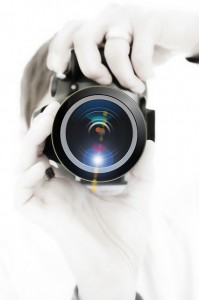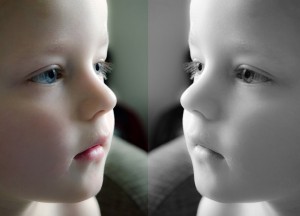Recently an editor contacted me about a query I had sent her quite some time before. She stated an interest in reading the entire manuscript, if I would rewrite it to address some of the limitations inherent in using first person point of view–namely the inability to know what other characters are thinking or feeling.
The story, which is about one person’s experience with clinical depression, had seemed so internal that I hadn’t questioned using first person POV. Now, however, I’ve taken a step back to look again at how best to tell the story–or, in this case, who best should tell the story. It’s all about perspective, just like with painting. Change perspective and you change what one notices in the picture. Change the POV and you change what the reader can experience in the story.
So the problem becomes, again, what do I want the reader to experience, and what POV best achieves that? In an attempt to decide which POV might be best for this story, I went back to my writing books. The Writer’s Little Helper by James V. Smith talks about first person (already tried that), second person (ruled that out), and third person–which is then split into 3rd person unlimited omniscient and 3rd person limited omniscience. The author notes basically no disadvantages for using 3rd person limited, so that seemed to be the way to go.
Still feeling like I didn’t have a handle on that perspective, I turned to Alicia Rasley’s book The Power of Point of View–and found that there is even more distinctions within the third person POV. (no doubt, just to confuse me more) Rasley begins by breaking it into two groups — impersonal or personal. Impersonal is where no actual character narrates the story. Forms of impersonal POV includes objective, classical omnisciency, and contemporary omniscient. In third person personal, however, the POV is within a character.
Following is a breakdown of those distinctions (both for your benefit and mine) taken from Rasley’s book.
Third-Person Objective: Think of this as the camera-eye POV because it is just recording what is going on–not offering any type of interpretation or commentary. Advantages: objective description is often considered ‘true’ by the reader, it can quickly convey factual info., it adds a gritty tone (good for adventure and detective novels), and because info is restricted, objective can show action without giving away too much detail. Disadvantages: gives no interpretations and allows for no nuance, it ignores the internal and emotional reality, and the clinical tone strips away color and depth. POV theme: “Objective POV explores whether there is an objective reality, apart from each of our own interpretations.”
I think I can rule this out. I went with first person originally in order to make the story personal, to get the reader to feel what it is like to suffer from clinical depression. Third-Person Objective seems too distant–although I do like the idea that it explores an objective reality.
Third-Person Classical-Omniscient: has a narrator that knows everything about
everything. This adds a sort of filter between the reader and the characters. Advantages: can help connect large casts and multiple settings, irony and humor are easier when characters are viewed from a distance, helps foreshadow coming events, gives an outside commentary on the characters – plus more information than the characters could know, and it is helpful to set the mood and provide cliffhangers. Disadvantages: distances the reader (so could be good or bad depending), detract from protagonist, can be hard to figure out what each individual character knows (not good in mysteries), sometimes leads to more telling instead of showing, and can eliminate the exploration of characters through their individual voices. POV theme: “Classical omniscient explores human society: How do we interact and why?”
I’m going to rule this out as well. Again, don’t want a filter between the reader and the characters.
Third-Person Contemporary Omniscient: has the same comprehensive view as classical omniscient, but lacks the narrator. It is also more flexible than classical-
omniscient POV, but still has most of the same pros and cons. Advantages: good with large cast and multiple settings, moves from one character to another/one place to another as suits the action, helps smooth transitions between different simultaneous events, and allows for greater scope in presenting action and description within a scene because the writer isn’t stuck with the perceptions of one or more characters (like with personal POV). Disadvantages: easy to show actions so it can lead to too much action taking place away from main characters, can result in dry factual narration without voice of classical narrator, and it can become head-hopping if not careful. POV theme: “Contemporary omniscient explores the conflict between our need for society and our need for freedom.”
I like that the author makes note that you can use contemporary omniscient to transition into or out of a scene, but then sink into single or multiple POV. I like the flexibility of this — the zooming out for a broader view (putting certain actions/thoughts/emotions into context) and then zooming in for a closer look. I also really like the theme that contemporary omniscient illustrates. It fits well with the struggles of my main character. I might consider trying this POV.
Third-Person Singular: when you use only one character at a time to narrate the events of a scene. Advantages: the readers get the whole scene from one person’s perspective, it is easier to keep track of who knows what, the author can develop a unique view of each event because it goes through one person, and the reader can learn much more about the POV character through the thoughts/actions/perceptions. Disadvantages: reader is confined to one perspective, whatever bias the POV character has will distort the narration and this will not be apparent right away, and while the reader is getting to know that one character, the others in the scene will remain somewhat unknown. POV theme: “Single-third person explores the issue of the interior life: How do internal needs and conflicts drive an individual’s external actions?”
I’ll definitely try this POV. In the Point of View book, it does talk about how you can shift from a more contemporary omniscient to transition into a scene and then use third-person singular. I love that this POV explores the issue of an interior life and how it drives the external action — perfect for exploring depression.
Third-Person Multiple: when you use two or more characters to narrate a scene’s events. Advantages: allows the reader to experience events from different perspectives,
can give a second character’s version of an event without having to replay it in the next scene, can show how much characters are in agreement or disagreement, allows you to cut from one place to another/one person to another without ending the scene, and it can scan the crowd to show different reactions. Disadvantages: can easily lead to head-hopping, can cause readers to not identify with characters, can reduce reader involvement by telling rather than showing, can lead to redundancy. POV theme: “Multiple-third person explores the issue of perspective: What we see is very much dependent on where we stand.”
This might be interesting to use in my novel–have to think about it some more. Not sure if it would add or not. Our reality is all based on our perspective, so that might be interesting to play with. I think I’ll start with the other two possibilities and save this for Plan C.
Which point of view do you find the easiest to write? Which is the hardest for you? Have you ever written a novel in one point of view and then changed the whole then to another POV? What was the hardest part of making that change?








Wow!!! I didn’t know there were so many ways to use POV – very interesting. Thank you for sharing. Sue Guilford
I never really thought about POV this way either. Very interesting to start looking at it in the books I like to read.
Sarah:
Your posting is extremely well done. It was a pleasure to read and think along with you. Thanks for making the effort.
Patrick
Too bad you can’t think FOR me. I could use that right about this time of the school year. : )
Sarah,
Were you somehow reading my mind! As a new writer, I am concerned with POV on a regular basis. Earlier today, on my current story that I’m writing, I was struggling some with POV. Your article has shown me that I need to do more research on this. I will check into the 2 books you mentioned. Thanks for the references. Your article was timely and well written. Lastly, I loved the graphics which synced up so well with the article.
Daniel
I really like the Rasley book. I keep picking it up and reading a chapter here or there. I always get something new from it.
And she’s not about rules. She talks about POV as a tool. I find it helpful to think of it that way–rather than a right or wrong way to do things.
Wow. Thanks for posting this. It’s all more confusing that I thought. So far I’ve done first person, which has too many limitations for me, and what I think might be third-person multiple, with only two people so far. (I kind of wish I’d expanded my reach so I could add more characters and POVs later. In a future project I will do that.) Some of these seem like very subtle differences, but I’ll have to reread to get clear.
There are rather subtle differences. For instance, you can have more than one point of view in the Third Person Singular. It’s just that you would have one POV per scene–whereas with Third Person Multiple you have more than one POV WITHIN a scene. In her book, Rasley gives the The Last Battle by C.S. Lewis as an example. If you have read that book, there is a scene with Puzzle the donkey and Shift the ape and you see the events first from Puzzles POV and then in Shift’s. Same scene. Adroitly done.
The thing I got most from the book is that POV can be used to add depth to the story–like shading in a drawing. I never really thought about it as a tool before. I’m eager to give some of these POVs a try.